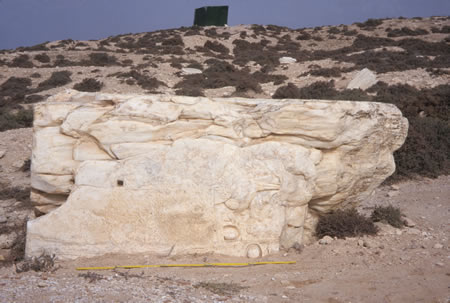SOUTH TEMPLE

Located several meters from the highest mound at Meninx are the largest architectural fragments. While there are limited remains and no epigraphic evidence to confirm that this structure was a temple, the fragments’ dimensions strongly suggest that these blocks were from a temple. The only visible remains of this massive temple are one column base, two fragmentary capitals, a few entablature fragments, and one of the largest mounds in the city. The column base diameter (1.04 m) suggests a columnar order of c. 35 RF. Two capitals can be connected to this structure. Although poorly preserved, the calyx appears to be divided into three parts, which according to Ferchiou, suggests a post-Trajanic date. Several fragments remain from the architrave. Three have the bead and reel partially preserved and two have the soffit decoration preserved. The fullness of the eggs and their casing in the egg and dart frieze on fragment 98.21 again suggests an Antonine date for the fragment, and thus the temple. It is difficult to comment on the form of the temple. Due to the steep mounds, the magnetometry evidence is extremely limited. A wall with approximately the same orientation as the basilica was located on one of the mounds. This wall was presumably from the temple, while other visible elements nearby could be from a surrounding portico. A temple set within a portico, as this temple seems to have been, was very common in North Africa.
